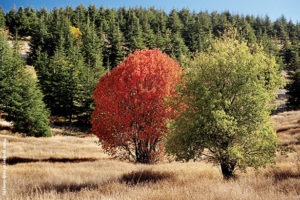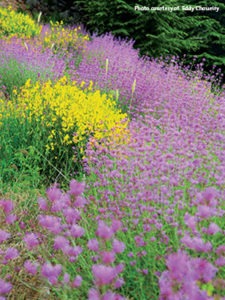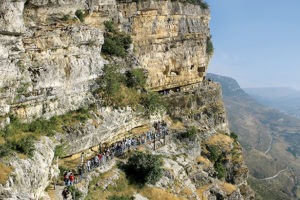The largest of Lebanon’s nature reserves, Al-Shouf Cedar Nature Reserve stretches from Dahr Al-Baidar in the north to Niha Mountain in the south. Blanketed with oak forests on its northeastern slopes & juniper and oak forests on its southeastern slopes, the reserve’s most famous attractions are its three magnificent cedar forests of Maasser Al-Shouf, Barouk and Ain Zhalta-Bmohray. These cedar forests count for a quarter of the remaining cedar forest in Lebanon, & some trees are estimated to be 2,000 years old.
What To Do Within The Reserve
The Al-Shouf Cedar Nature Reserve is a popular destination for hiking and trekking with trails matching all levels of fitness. Bird watching, mountain biking and snowshoeing are also popular. From the summit of the rugged mountains, visitors will have a panoramic view of the countryside, eastward to the Bekaa Valley and Qaraoun Lake and westward toward the Mediterranean.
What To See Around The Reserve
You might consider spending a couple of days exploring the historical sites and traditional character of the reserve’s neighboring villages, such as Ain Zhalta, Deir El-Qamar, Barouk, Maasser Al-Chouf and Niha. Important historical sites in the vicinity include the Beiteddine Palace, Mosque of Fakhreddine I, several old churches, and the village of Moukhtara (location of the Jumblatt palace).
In addition, you may enjoy Moussa Castle, the Marie Baz Wax Museum, the Kfarhim Grotto and Ain Wzain Grotto. Traveling to the east from the Maasser El-Chouf area takes you into the Bekaa Valley, where you can visit Kefraya Winery, the Aammiq Wetlands (good for bird watching) and Qaraoun Lake.
Don’t Miss The Niha Entrance
Shqif Tyron also known as the Fortress of Niha, is located in the southwest part of the reserve near the village of Niha. The fortress overlooks Jezzine and was used by the Crusaders as an observation point onto the road that used to link Sidon to the Bekaa Valley. The Fortress is famous for being the place of refuge for Emir Fakhreddine II who was trying to escape capture by the Ottomans in 1633 A.D.

History
Al- Shouf Cedar Nature Reserve was established by Law No.532 on July 29, 1996. The Reserve is managed by an Appointed Protected Area Committee in cooperation with the Al-Shouf Cedar Society and under the supervision of the Ministry of Environment. The UNESCO declared the Reserve and surrounding villages “Shouf Biosphere Reserve” in 2005.
What Is A Biosphere Reserve?
Biosphere reserves are areas of terrestrial and coastal ecosystems promoting solutions to reconcile the conservation of biodiversity with its sustainable use. Biosphere reserves serve in some ways as ‘living laboratories’ for testing out and demonstrating integrated management of land, water and biodiversity. Collectively, biosphere reserves form a world network: the World Network of Biosphere Reserves. Within this network, exchanges of information, experience and personnel are facilitated. There are over 500 biosphere reserves in over 100 countries.
Difference Between A Biosphere Reserve and A Natural World Heritage Site
A biosphere reserve is a representative ecological area with 3 mutually reinforcing functions: conservation, sustainable development and logistic support for scientific research and education. Natural World Heritage sites must be of outstanding universal value in accordance with the UNESCO Convention on the Protection of the World Cultural and Natural Heritage (1972). In some instances, a core area of a biosphere reserve can meet World Heritage criteria: the usually larger biosphere reserve can therefore serve as a complementary means to protect the integrity of the World Heritage site.
How To Get There

Best Season To Visit
The period from May to September is the best season to visit depending on the activities you enjoy. For floral enthusiasts, spring and summer are especially good times to visit the reserve. Flowers and plants can be identified with the help of reserve guides and the wooden signs peppered along the trails specified for walking.
Animal lovers will enjoy using the hidden post in Ain Zhalta-Bmohray forest and Ain Elligeh for birds and mammals observation. It is also possible to do nighttime monitoring via jeep using geographic positioning system (GPS), and night vision binoculars. Spring and summer are the best seasons for these activities.

What To Bring
In general visitors should come equipped with good hiking or walking shoes, comfortable clothing, backpack and water and take the following seasonal requirements into consideration:
- Sumer/ Spring: Water and sunglasses.
- Autumn: Jacket, hat and warm clothes.
- Winter: Snow clothes, hat, snow glasses, gloves, snowshoes (limited quantities can be rented at gates).
Optional: Visitors may also want to bring a field guide, camera, binoculars and a walking stick.

How To Get Into The Reserve
There are four main entrances to the reserve:
- Ain Zhalta
- Barouk
- Maasser el Chouf
- Niha
Restaurants near Barouk Entrance
- Tourist Restaurant +961 3 231 768. Tourist Restaurant & Guesthouse | Facebook
- Pinacea Café +961 71 232 771
- Baytna Restaurant +961 3 841 456. baytna.info
Where To Stay
• In Ain Zhalta El Eid Guesthouse
• In Baadarane Baz Guesthouse 05 311 191 – 03 702 944
• In Beiteldine Mir Amin Hotel 05 501 351
• In El Khraybe El Ashkar Guesthouse 03 354 558
• In Maasser El Chouf Auberge Saint Michel and Beit El Hana 05 350 451, Boustany and Mahmoud Guesthouses
• In Niha Merchad Guesthouse 05 330 755
How You Can Help
Buy a “Cedars and Faces” tour package (available from 1 to 5 days) or adopt a cedar tree. But it is best to visit the Park House to get more information about the reserve and biosphere and how contribute to their income.

Contacts
- Kamal Abou Assi: +961 3 964 495
- Park House Maasser El Shouf village square (facing public garden Al Shouf). Tel: +961 5 350 250. E-mail: arzshouf@cyberia.net.lb – info@shoufcedar.org. Facebook: Shouf Biosphere Reserve
- shoufcedar.org
Local Guide
 Marwan Khodr 70 252 762 has been working as an environmental guide for over a decade. Based in Baaqline, Marwan knows every nook and cranny of his hometown and the green spaces surrounding it. Marwan has learned to recognize endemic species such as local birds and plants. He spent much of his time with old village people recording their habits and customs.
Marwan Khodr 70 252 762 has been working as an environmental guide for over a decade. Based in Baaqline, Marwan knows every nook and cranny of his hometown and the green spaces surrounding it. Marwan has learned to recognize endemic species such as local birds and plants. He spent much of his time with old village people recording their habits and customs.
A Local Imitative For Sustainable Tourism
Preparations for the Beyond Beirut Annual Forum for National Sustainable Tourism Development scheduled for the 5th of October 2011 are well underway. The Forum aims to promote dialogue and linkages among tourism stakeholders in rural areas as well as between these stakeholders and national tour operators, with the goal of supporting the expansion of rural and sustainable tourism across the value chain in Lebanon.
The Forum will take place at the UNESCO Palace in Beirut. The conference sessions of the forum will see the intervention of representatives of key world organizations such as the Global Sustainable Tourism Council and the World Wildlife Fund, as well as Siyaha, Jordan.
The local picture will be represented by a number of managers, consultants & entrepreneurs of major tourism projects in the country, some of them representing leading sustainable tourism initiatives.
The exhibition part of the forum will feature a number of Lebanese Municipalities that will showcase tourism services offered by local tourism providers, as well as syndicates and private initiatives.
This Forum will be made possible with the support of the American people through the United States Agency for International Development (USAID) and by the support of sponsors such as ATTAL and SAAD Transport. The forum counts amongst its media partners MTV, The Daily Star newspaper, Tourism Around The World e-publication and Almughtareb magazine.
The forum is open to tourism industry professionals.
Simply call 03 016 607 or visit beyondbeirut.com for more information.
Article edited on November 17, 2021
Loading
